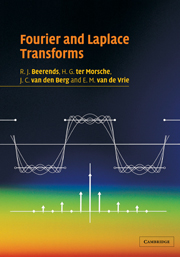Book contents
- Frontmatter
- Contents
- Preface
- Introduction
- Part 1 Applications and foundations
- Part 2 Fourier series
- 3 Fourier series: definition and properties
- 4 The fundamental theorem of Fourier series
- 5 Applications of Fourier series
- Part 3 Fourier integrals and distributions
- Part 4 Laplace transforms
- Part 5 Discrete transforms
- Literature
- Tables of transforms and properties
- Index
5 - Applications of Fourier series
Published online by Cambridge University Press: 05 June 2012
- Frontmatter
- Contents
- Preface
- Introduction
- Part 1 Applications and foundations
- Part 2 Fourier series
- 3 Fourier series: definition and properties
- 4 The fundamental theorem of Fourier series
- 5 Applications of Fourier series
- Part 3 Fourier integrals and distributions
- Part 4 Laplace transforms
- Part 5 Discrete transforms
- Literature
- Tables of transforms and properties
- Index
Summary
INTRODUCTION
Applications of Fourier series can be found in numerous places in the natural sciences as well as in mathematics itself. In this chapter we confine ourselves to two kinds of applications, to be treated in sections 5.1 and 5.2. Section 5.1 explains how Fourier series can be used to determine the response of a linear time-invariant system to a periodic input. In section 5.2 we discuss the applications of Fourier series in solving partial differential equations, which often occur when physical processes, such as heat conduction or a vibrating string, are described mathematically.
The frequency response, introduced in chapter 1 using the response to the periodic time-harmonic signal eiωt with frequency ω, plays a central role in the calculation of the response of a linear time-invariant system to an arbitrary periodic signal. Specifically, a Fourier series shows how a periodic signal can be written as a superposition of time-harmonic signals with frequencies being an integer multiple of the fundamental frequency. By applying the so-called superposition rule for linear time-invariant systems, one can then easily find the Fourier series of the output. This is because the sequence of Fourier coefficients, or the line spectrum, of the output arises from the line spectrum of the input by a multiplication by the frequency response at the integer multiples of the fundamental frequency.
For stable systems which can be described by ordinary differential equations, which is almost any linear time-invariant system occurring in practice, we will see that the frequency response can easily be derived from the differential equation.
- Type
- Chapter
- Information
- Fourier and Laplace Transforms , pp. 113 - 134Publisher: Cambridge University PressPrint publication year: 2003



